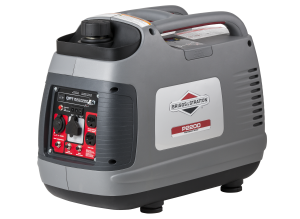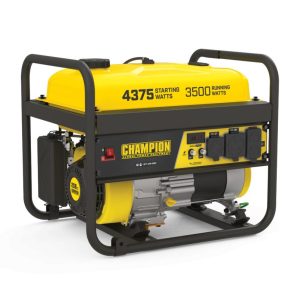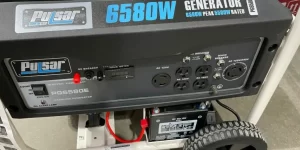Resolving RYOBI Generator Overheating when Working Hard!
The generator is on, but it’s not very powerful. Sounds like it’s slowing down a lot.
If the generator is being asked to perform more work than it can do, if the carburetor is dirty, if the fuel filter is clogged, if the air filter is clogged, if the choke is jammed, or if the spark arrestor is clogged, the RYOBI will bog down and run rough.
For your own safety, wait for the engine to cool down and remove the spark plug boot before beginning any repairs.
Table of Contents
6 Causes of RYOBI Generator Sluggishness Under Load
The RYOBI Generator Is Overworked
Power tools made by RYOBI are not uniform. While the generator’s wattage capacity remains constant, the maximum loads vary. In case you go beyond these parameters, the generator may sputter and even turn off.
Not only would this slow down your RYOBI’s performance, but it might also damage the generator and anything else you have plugged into it.
It’s important to know the generator’s load limit and the wattage needs of the devices you’re powering with it before inspecting it for potential sources of poor operation.
On the generator itself, you’ll see ratings for both starting and running watts. The total wattage of all the appliances you want to power at once must be less than the generator’s safe operating load.
Temporarily powering appliances that demand more electricity than the generator can supply is called a “starting load,” and it will max out the generator’s capacity.
For help figuring out the wattage, consider the following:
- Most electrical appliances include a label that specifies their wattage.
- For some motors, more power is needed to get things going. The required wattage in this scenario should be determined by using the initial wattage.
- To get a total, add up the wattage of everything that will be hooked into the generator at once.
- The sum of these watts must be lower than the maximum allowable for the generator.
Never use the generator to power more appliances than it can sustain. Turn off the power source if the machine stalls. Take everything out of the ports. To add more items, you should restart the generator after each addition.
A RYOBI Generator with a Filthy Carburetor
The accumulation of varnish in the carburetor can render it ineffective after some time. Damage to the carburetor’s fuel delivery system can occur when varnish forms on its internal surfaces as a result of prolonged exposure to stale gas.
The engine won’t start because the gasoline-air mixture won’t explode if there isn’t enough fuel. To restore functionality, a clogged carburetor requires removal for cleaning or rebuilding.
Taking pictures while you disassemble the carburetor to clean it is a good idea so that you can put the minor parts back where they belong.
The generator’s carburetor must be removed. The use of a carburetor cleaner should be employed to remove as much of the accumulated gunk as possible. A carburetor rebuild kit can be used to replace any broken components. The carburetor must be removed, cleaned, and fixed before being reinstalled.
As an alternative to dismantling the carburetor and cleaning and rebuilding it, you can simply buy a new one. If cleaning the carburetor on your RYOBI doesn’t make it work, you might want to consider purchasing a new one.
Blockage in the RYOBI Generator’s Fuel Filter or Sediment Bowl
If you want to protect your RYOBI generator’s engine from wear and damage, you should install a fuel filter.
It’s possible that the fuel valve is also equipped with a sediment bowl or that an inline filter is located between the fuel lines. Insufficient fuel flow may occur if the filter becomes clogged or the sediment basin is overflowing.
Most households who regularly use their generators should change the fuel filter or at least empty and clean the sediment bowl once a year. If you intend to use it frequently, you should perform this upkeep more frequently.
Get in touch with a RYOBI service facility if you have questions about whether or not a fuel filter is necessary and where exactly your machine’s fuel filter is situated.
A RYOBI Generator with a Clogged Air Filter
The engine can be severely damaged by even a little amount of dirt or particles, but an air filter prevents this from happening.
The air filter, like the fuel filter, should be changed at least once a year, or more often if the generator is used often or in dusty environments.
The air filter needs to be cleaned and replaced regularly. Filter condition and cleanliness must be monitored on a regular basis between filter changes.
When the filter gets too dirty, it restricts the airflow to the engine and causes it to overheat. Overheating and stalling can be disastrous for an engine.
Before using, make sure the air filter has been cleaned or replaced if necessary. If you want to clean your RYOBI, just do as it says in the user handbook.
In this post, I will show you how to clean a few different kinds of air filters. If you are unsure how to clean your air filter, it is recommended that you refer to the manual.
How to maintain a RYOBI generator’s foam-style air filter:
- To replace the air filter, you must first remove it from its housing.
- To clean the air filter, remove the top and wipe out the inside. Don’t let any grime settle into the vents that supply air.
- Check for wear and tear on the foam filter, and replace if necessary.
- You can check the filter’s condition by washing it in soapy water and rinsing it until the water comes out clear.
- The filter needs to be squeezed and then let to dry.
- Put in the filter for the air conditioner.
- Put back the air filter cover.
Cleanse a RYOBI generator paper air filter:
- To replace the air filter, you must first remove it from its housing.
- Clean the air filter housing and cover with a damp cloth. Don’t let any grime settle into the vents that supply air.
- Paper air filters should be inspected regularly. Gently tapping the filter might help loosen dirt and prompt it to fall out of the filter. The paper is fragile, so please handle it with care. Clean or replace the filter if it is unclean, broken, or is no longer doing its job of keeping the air in.
- Put in the filter for the air conditioner.
- Put back the air filter cover.
Jammed RYOBI Power Tool
When the choke isn’t readjusted once the engine has warmed up to allow enough air to get to the engine, the generator can stall for lack of airflow.
Possible causes include failing to turn off the choke once the engine has warmed up. A jammed choke or malfunctioning switch/dial (depends on model) used to ignite the generator could also be to blame.
An RYOBI Generator with a Blocked Spark Arrestor
A RYOBI generator’s muffler is equipped with a spark arrestor screen to contain any stray sparks or hot particles before they escape. For safety reasons, this must be done to prevent fires and burns.
Carbon accumulation on this metal screen prevents hot exhaust air from leaving the engine, causing the generator to operate roughly or even shut down.
Wait until the muffler has cooled down before attempting to remove the spark arrestor for cleaning. Check the condition of the spark arrestor screen by removing it. If you discover any holes or tears in the mesh screen, you should get a new one.
If the screen is still functional, you can wipe it down with a commercial solvent or give it a quick brushing with a small metal brush to get rid of any soot buildup. Return the screen to the muffler after cleaning it.
Read More: RYOBI Generator








